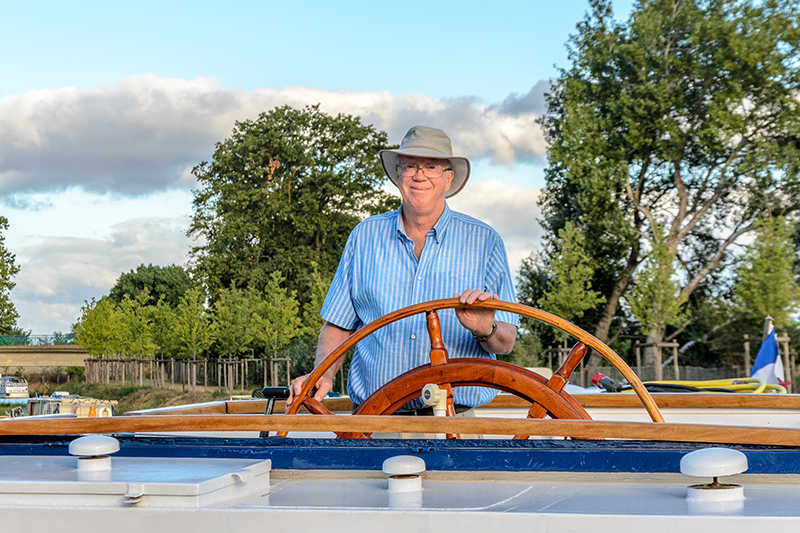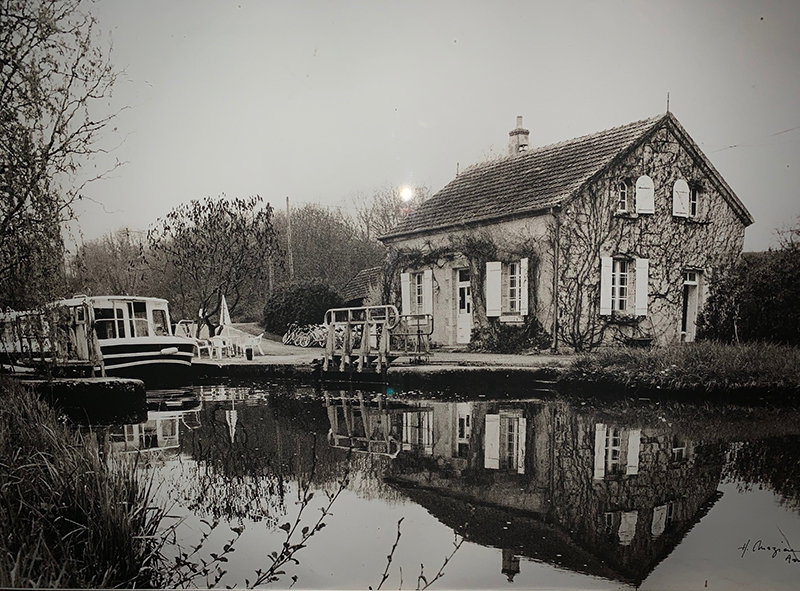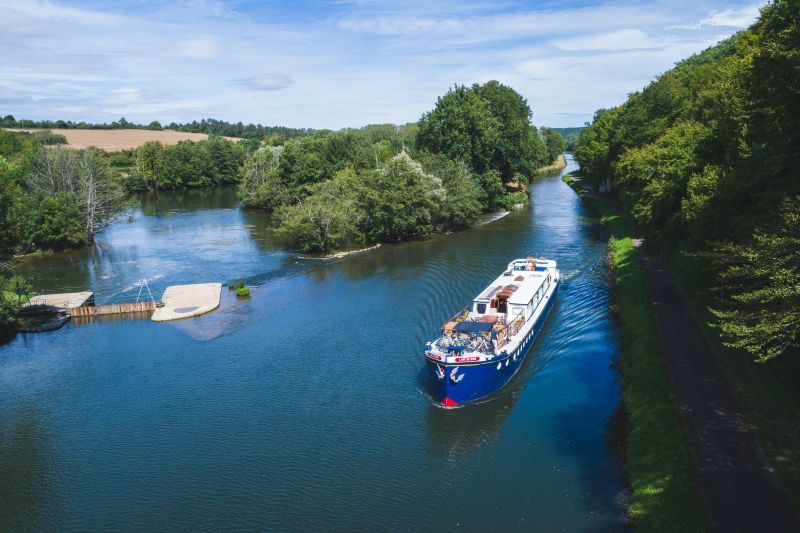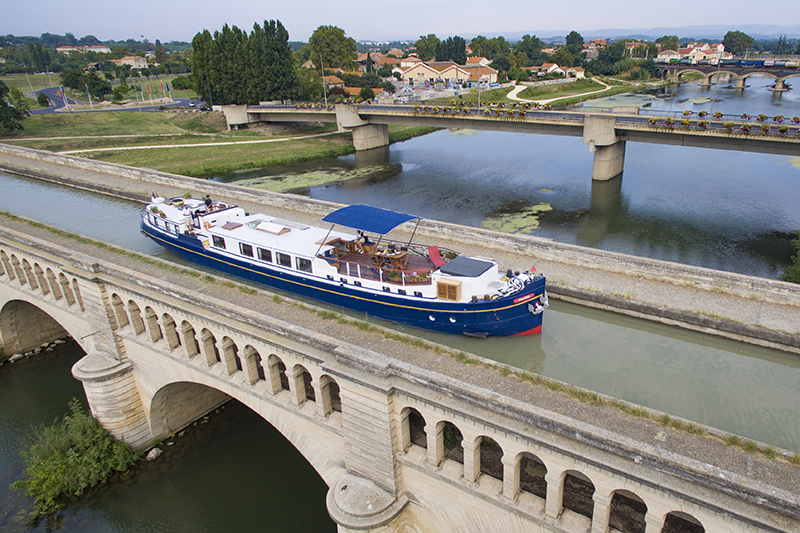A question I am often asked when cruising with passengers aboard our fleet of hotel barges is “which is your favourite route, Derek?”
My Favourite Waterways by Derek Banks

Invariably this question comes along towards the end of a voyage, when barging has had time to cast its spell, and folk are trying to figure out just which of our barge cruises to try next. Of course, all our routes have great appeal, so there is no simple answer. At European Waterways, we have spent 50 years trying to perfect each journey: pioneering new routes, seeking out fascinating excursions that are so unusual, they leave long-lasting impressions, building special relationships with owners of vineyards, châteaux, market stalls and so much more – all to create travel memories which we hope our clients will keep forever.
For me, just being afloat anywhere is my idyll. I am a boat chap: regardless of its size – from a dinghy to a cross-channel ferry, I always enjoy the movement of the boat on water, eagerly anticipating what’s around the next bend. It’s the magic of the waterway itself which captures my own imagination: the canal architecture, the curve of the canal as it follows a contour, the bridges and locks that were formed hundreds of years ago.
Add scenery, great food and fine wine, good company and a unique floating hotel and there’s little surprise hotel barging has stood the test of time!
Of course, I am biased: In 1976 I cast an eye for the first time on the southern section of the Nivernais canal and a tiny lock house, Maison Eclusiere de Fleury, which was soon to become home. I fell in love with France and rural Burgundy. It was December and very cold, I was 23 and so began a life’s work. Discovering the Canal du Nivernais, with the unique way this manmade ancient waterway fuses with the wooded upper reaches of the River Yonne, the picturesque locks and lock houses numbering over 100, all different as if a university of engineers had been given a lock each to design…such enchantment.

So what is my favourite route? There’s no clear answer to this question, and if I am honest – I wouldn’t like to tell you to re-book an area you may have already visited. Our ethos is to encourage our clients to explore and understand the delights of all the waterways we operate on, so here’s a personal insight into my top three European waterways…
1. The Canal du Nivernais, Burgundy
The Canal du Nivernais runs along the edge of the Morvan hills about 250 km south of Paris in Burgundy. The pine forest hills are over 900-metres-high, and the raison d’être of the waterway from a millennium ago. Before the canal was completed in 1841, the forests were farmed, and logs would be grouped together and flushed down the river Yonne as far as Paris with the Spring floods. This was a whole industry which gradually developed with the taming of this fast-flowing river and gorgeous rural landscape.

Barges arrived at first, upstream as far as Clamecy in the Nievre department of Burgundy, and then up to the summit level which has three tunnels and a feeder lake called L’etang de Baye. Sleepy white Charolais cattle pay no attention to us as we drift slowly past. The limestone cliffs of Saussois, cut out by millions of years of erosion, create a surreal backdrop to a night’s mooring. The colourful flowers, green pastures and abundance of birdlife beckon as we journey back in time to the industrial revolution of the 19th century. L’Art de Vivre is the perfect vessel for the Nivernais. Manoeuvrable at just 30 metres in length, she fits everywhere and recently went up to the summit and ‘over the top’ to the south – the first barge to do so in years. Even the local mayor came rushing out to see us! Close to the Chablis vineyards and beneath the basilica in Vézelay with homely small châteaux and village markets, the Nivernais will always be my first choice. This is the most enchanted waterway in Europe.
2. Scotland and its Highlands
A very close second recommendation has to be Scotland and its Highlands. Created by Thomas Telford, Britain’s foremost canal engineer, as a sea going shortcut to avoid dangerous Cape Wrath in the far North, the Caledonian canal is unique. Opened in 1822, the canal links four lochs: Dochfour, Ness, Oich and Lochy to the immaculate series of canal sections. Each Loch has a different character. Ness is 25-miles-long and over a mile wide, and the drive along the south shore along the single-track road is gorgeous.
My favourite of the lochs is Loch Oich at the summit level – with one side opening-up to a view of Britain’s highest mountain: Ben Nevis and the other side to the ruins of Invergarry castle of Clan MacDonell. You’ll be crossing from one side of Scotland to the other on a hotel barge! This is extraordinary scenery.

It’s not uncommon to see a stag wandering in the distance, Golden Eagles circling high overhead and otters playing in the morning mist. “Four seasons in a single day!” – is a comment you’ll often hear. Yet the scenery in Scotland doesn’t alter with the seasons – it’s always stunning. Our cruise is deeply rural with the village of Fort Augustus and its abbey in the middle. A real joy and something highly unusual on Europe’s inland waterways is to see a sailing boat approaching under full sail. It’s a canal: there are bridges, surely no yachts can navigate? But Telford knew what to do and designed the canal with sail in mind to keep the Royal Navy happy. The same swing and opening bridges are there today and sailing boats with up to 174ft air draft and 16 feet water draft can safely use this waterway. The Highlands are full of history, clan myths, folklore and legends which you’ll have the opportunity to learn about on our fantastic Scottish cruises.
We carry 18 single malts behind the bar, (3 a day seems fair!), we visit ancient castles, clan battle grounds and a whisky distillery. We have two fine vessels: Scottish Highlander and Spirit of Scotland. How these vessels even got to Scotland is worthy of a book!
3. Canal du Midi, Southern France
This is really difficult choice to make. The Veneto in Italy is a strong contender with so much history and Renaissance architecture. Then Holland is so full of barges, windmills and flowers – gorgeous in the Spring… However, my third choice though must be the Canal du Midi in the South of France.
I first visited in 1978 on the way to Morocco, at the end of my second season in Burgundy. Everything felt so old – black stonework from the Languedoc volcanic hills certainly caught my attention. If you want to build a canal, use volcanic rock – that’s how it was done in 1650 when Pierre Paul Riquet mapped out the route between the Mediterranean Sea and Atlantic Ocean, and he built it to last. Whilst the Romans thought up the idea of a canal to avoid a 2,000-mile sea route via Gibraltar, it took another 1,500 years to complete. The whole problem was how to efficiently supply the water, which Engineer Riquet worked out, capturing the year round flows of the rivers, building feeder lakes and even following the contours to save water usage.

Everything about the Canal du Midi is special. Whilst most of France’s locks are rectangular, the locks on the Midi are ovoid, which reduces the stress on the walls from surrounding ground movement. Everywhere you look there are the Minervois and Corbieres vineyards stretching to the horizon. To gaze from the tiny village of Poilhes near Beziers across over 100 miles to the snow-capped Pyreneees on a clear morning is spectacular. Crossing the River Orb aqueduct beneath Beziers Cathedral is breathtaking. The canal is torturously twisty as it follows the contours – it’s so exciting from a Captain’s point of view! And for guests, watching from the sundeck as the vista unfolds with a glass of chilled rosé (or perhaps from the decktop spa pool) is very special too. The route enjoys Roman history in Narbonne and the Via Domitia, the medieval fortified town of Carcassonne, a voyage from the saltwater lagoon of Étang de Thau (home to the village of Marseillan, Noilly Pratt, Oysterbeds and sailing boats), past salt marshes and flamingos to Agde – the second oldest town in the French Mediterranean with Greek and Phoenecian stonework dating back 3000 years.
The Canal du Midi is certainly my third choice, but then maybe it should be first? Our original hotel barge, Anjodi was built here in 1982 after a trans-European journey from Amsterdam, but that’s another story…
 English
English
 Spanish
Spanish French
French German
German Norwegian
Norwegian Portuguese
Portuguese Swedish
Swedish Italian
Italian Russian
Russian Simplified Chinese
Simplified Chinese Japanese
Japanese

